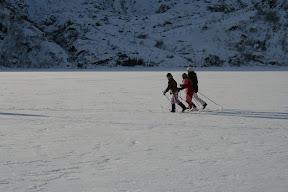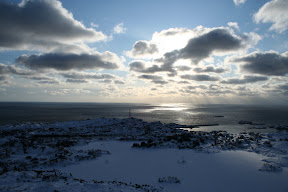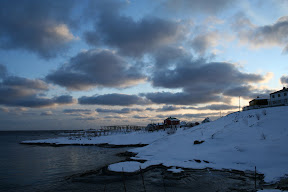Day 5 (Monday 22 february 2010) - Sørvågen - Reine - Sakrisøy - Hamnøy
On Monday, finally the bus schedule is richer than the weekend and we plan to visit two villages which, according to the guides, are worthy to see.
One of these is Reine, a good starting point for hikes, one of which sounds really interesting; unfortunately, it's not possible to do it because during the winter the trails is very difficult, and moreover, after two days of sun, clouds start to cover the islands and soon snow and wind will be with us!
The bus (39 nok) leaves us at the first destination, the farest from our basecamp in Sørvågen, which is Hamnøy: few houses on a small island at the end of the namesake fjord. On paper it should be a great viewpoint, but with bad weather it's not so interesting, and we just take a breath-taking look at the North sea from a sea cliff.
Hamnoy is connected with two nice bridges, which we across walking on the E10 towards South, to Sakrisøy, another small village on another small island. Here we leave the main road to take a wilder walk on the side, to have a better view on the fjord and the mountains. A small hill offers us the irresistible opportunity to roll along its side as a sack of potatoes....it's very funny, but the price to pay is to have snow everywhere on our clothes! Close to the hill we find a small pic-nic table which must be absolutely fantastic in the summer, with a great look on the fjord. Now it's winter, cloudy and windy, but we cannot resist to have a break and eat something.
After the break, we start again our walk on the E10 towards Reine; after some steps it starts to snow and the wind start to blow stronger. Luckily it's not so cold, because when it rains usually the temperature goes up, even if we need to walk completely covered, just with an opening for the eyes. Just after Sakrisøy we find a Coop supermarket which is perfect for a quick break! We also find that it has a lot of beautiful postcards and souvenirs, so it's a good occasion because tourist offices, in the winter season and in the weekend, are almost always closed. When we start again our walk, we are in the middle of the snowstorm, and when we finally reach Reine the weather starts to be good again. Reine is the last village, on the way to the South, where you can find some services as a ATM, where you can withdraw money with any credit/debit card. There is a nice kiosk too, with warm meals and souvernirs. Waiting for the bus, we take a walk to the cliff and the lighthouse, which is again made in iron, and colored in red and white. Maybe I've already talked about this, but these lighthouses, which stud the whole norwegian coastline from north to south, well they are particularly fascinating. They are there, alone against the wind and the waves, located in some amazing places like cliffs or small islands, and they make their job in an efficient way. We could say that they represent, in a way, the scandinavian efficiency which, despite the weather, is almost perfect.
On the cliff we find a big block of frozen ice, anchored to the ground....well, I know i'ts stupid, but we don't resist to try to detach it and make it roll in the sea. We succeed in the first task, but then we realize we're late for the bus...well, we weren't really late, because the bus was not running. Why? I ask to the lady in the Kiosk, who explains us that this week all the schools were closed, therefore the buses have a reduced timetable. But why? Well, the reason is that it's winter. Here the point; Norwegians can have an holiday just because it's winter, the weather is good, there is snow, and so....everybody is skiing! It's quite difficult to find a people more relaxed than this in Europe.
For us, stressed italian people, the only option now is to walk. It'sd 7 kilometres, and after a long day outside it's not a grea pleasure. Just after Reine there is also a short tunel, but the wise norwegians built an external path for pedestrians and cyclists. We try, in vain, to hitch-hike the few cars on our way unless, luckily, a car stops: it's the woman who were working in the kiosk.
In the evening we take bag and baggage for the last transfer to the other accomodation, because the ancient rorbu was already booked for another guest. The owner bring us to Å, the village that we visited the 4° day, in a spacious and modern rorbu. Our last dinner on the Lofoten island, worthy after the tirying day, was with three-coloured fusilli (red, green and white, the colours of the italian flag) with italian tomato sauce, "Taste of Sorrento", not before a tribute to the flag and national anthem.
Friday, April 30, 2010
Thursday, April 15, 2010
Our trip over the norwegian polar artic circle, Lofoten islands - Day 4
Day 4 (Sunday 21 february 2010) - Sørvågen - Tind - Å
Forth day, and another wonderful sunny day which will follow us for an adventurous hike! The morning sunlight let us to enjoy Sørvågen, a traditional village, underestimated by the travel guide, located around an active harbour surrounded by superb mountains. It's a perfect base camp for hikes and in general to visit the nature of the southernmost island of the Lofoten archipelago, which is the most beautiful according to many travellers.
The owner of the accomodation recommends us to do an hike on the mountains around, so we start to walk in the direction of the mount which dominates the village, and surrounds on the right side a big frozen lake.

The climb is quite easy thanks to the soft snow which helps us not to become an human avalanche...and meter after meter the landscape becomes more and more breathtaking.

Finally on the peak we find a kind of plateau, at the slope of another mount which is too difficult to climb without any proper equipment and/or special skills, because of all the ice which covers its rocks. The view is amazing, and the light of the sun plays within the clouds giving an unreal effect.
On the plateau we find a long frozen sheet, like a perfect plate glass, and we cannot resist to the call of childhood, starting to slide on it in every possible way. After that, we take a break with hot tea (thanks to a very efficient thermos!) and crunchy norwegian chocolate. Then we start to descend to the frozen lake, and before placing our feet on it, we ask a man if it's safe. He reassures us: the ice is thick at least 50 centimetres!


As you can see, norwegians really like the cross-country skiing during the winter. It's said that norwegians are born with ski on their feet, actually it's true! Even in Oslo, which is a modern city, you can often meet people getting on buses and trams wearing a ski suit and bringing ski or snowboards. At the side of the footpaths, where the snow cumulates, you can always find the track of the ski left by people who goes to school, work, or simly to enjoy the nature.
But let's go back to our hike. After a walk on the frozen lake we go downhill and take a small break at home, where we decide to go out again to watch the sunset from the very south point, at the end of the E10 road on the Lofoten. We start walking on the road, straight to the last village of the island, called Å (pronounced as a kind of closed O).
It's about 3 kilometres, and the sensation is really to be at the end of something. It's exciting to see the physical end of the road (picture below) and find the sea after some metres.
Over this coastline, flows of water combines in some spots called Maelstrom. In this area you can find the strongest maelmstrom in the world. Sunset is the perfect friend in these moment, and the clear sky let us to catch a glimpse of the last two small islands of the Lofoten, Vaerøya and Røst.
Now we can only go back home, very satisfied for this wonderful day. But the adventures are not finished yet: on the way back we meet the owners of the house where we are sleeping, a nice couple who owns over 17 houses in the villages of Å and Sørvågen, in addition to the stockfish museum and a youth hostel! The husband speaks an almost perfect italian, and invite us to spend the night in a really traditional Rorbu, which is also the oldest of the village. Built in 1985, it's practically untouched thanks to the ordinary care and some restorations. The athmosphere inside the cabin is warm, welcoming and cosy, the kitchen is folksy, the wood is everywhere. Here some pics, and see you next time!

Forth day, and another wonderful sunny day which will follow us for an adventurous hike! The morning sunlight let us to enjoy Sørvågen, a traditional village, underestimated by the travel guide, located around an active harbour surrounded by superb mountains. It's a perfect base camp for hikes and in general to visit the nature of the southernmost island of the Lofoten archipelago, which is the most beautiful according to many travellers.
The owner of the accomodation recommends us to do an hike on the mountains around, so we start to walk in the direction of the mount which dominates the village, and surrounds on the right side a big frozen lake.

The climb is quite easy thanks to the soft snow which helps us not to become an human avalanche...and meter after meter the landscape becomes more and more breathtaking.

Finally on the peak we find a kind of plateau, at the slope of another mount which is too difficult to climb without any proper equipment and/or special skills, because of all the ice which covers its rocks. The view is amazing, and the light of the sun plays within the clouds giving an unreal effect.
On the plateau we find a long frozen sheet, like a perfect plate glass, and we cannot resist to the call of childhood, starting to slide on it in every possible way. After that, we take a break with hot tea (thanks to a very efficient thermos!) and crunchy norwegian chocolate. Then we start to descend to the frozen lake, and before placing our feet on it, we ask a man if it's safe. He reassures us: the ice is thick at least 50 centimetres!


As you can see, norwegians really like the cross-country skiing during the winter. It's said that norwegians are born with ski on their feet, actually it's true! Even in Oslo, which is a modern city, you can often meet people getting on buses and trams wearing a ski suit and bringing ski or snowboards. At the side of the footpaths, where the snow cumulates, you can always find the track of the ski left by people who goes to school, work, or simly to enjoy the nature.
But let's go back to our hike. After a walk on the frozen lake we go downhill and take a small break at home, where we decide to go out again to watch the sunset from the very south point, at the end of the E10 road on the Lofoten. We start walking on the road, straight to the last village of the island, called Å (pronounced as a kind of closed O).
It's about 3 kilometres, and the sensation is really to be at the end of something. It's exciting to see the physical end of the road (picture below) and find the sea after some metres.
Over this coastline, flows of water combines in some spots called Maelstrom. In this area you can find the strongest maelmstrom in the world. Sunset is the perfect friend in these moment, and the clear sky let us to catch a glimpse of the last two small islands of the Lofoten, Vaerøya and Røst.
Now we can only go back home, very satisfied for this wonderful day. But the adventures are not finished yet: on the way back we meet the owners of the house where we are sleeping, a nice couple who owns over 17 houses in the villages of Å and Sørvågen, in addition to the stockfish museum and a youth hostel! The husband speaks an almost perfect italian, and invite us to spend the night in a really traditional Rorbu, which is also the oldest of the village. Built in 1985, it's practically untouched thanks to the ordinary care and some restorations. The athmosphere inside the cabin is warm, welcoming and cosy, the kitchen is folksy, the wood is everywhere. Here some pics, and see you next time!

Subscribe to:
Comments (Atom)












